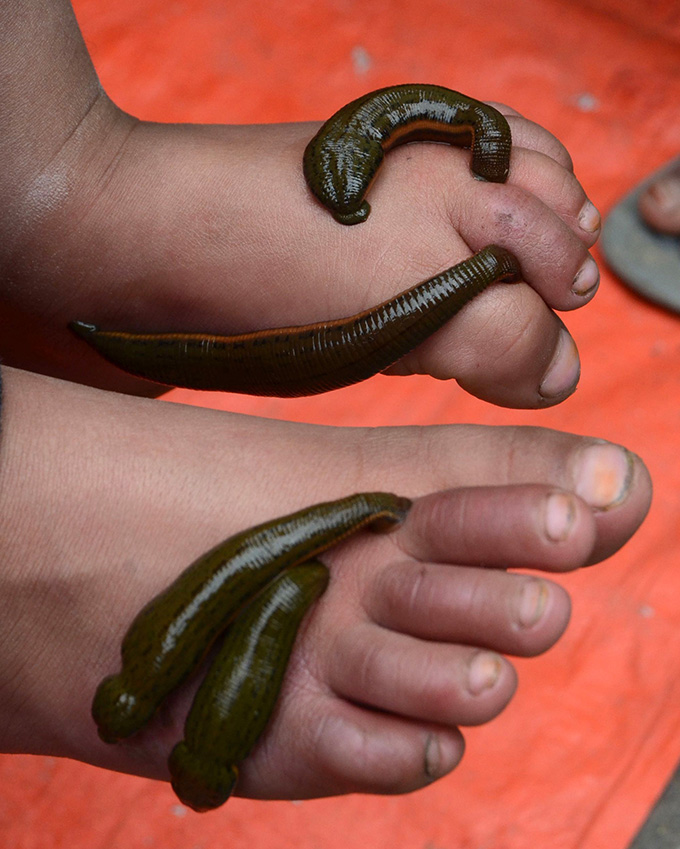
Hauled by his grandfather along the Hazratbal market, six-year-old Omer says no to everything he is offered. His left eye is swathed in a bandage but his right eye is filled with suspicion. Omer was hit by a cricket ball on his eye and the accumulating blood has turned black. Despite repeated assurances by his grandfather, Omer senses the purpose of his visit to Hazratbal – a treatment through leech treatment.
The duo arrives at the leech therapy clinic of Wali Mohammad, spread over a jute mat with a bunch of leeches wrapped in a piece of cloth in a clay pot. Omer sits nearby, reluctantly. At a wink by the grandfather, the therapist puts three leeches on Omer’s eyelid. He screams in pain, “Ha Khudayo (Oh God).” Though the treatment is painful, the grandfather smiles, probably at the prospect of treatment.
There are roughly 600 leech species that have been identified to date. However, only 15 of them are used in medicine. They are called medicinal leeches or Hirudo Medicinalis. Ranging from a half inch to ten inches in size, they are brown or black in colour. Leeches help in the restoration of blood circulation to grafted tissue and reattached fingers and toes. They secrete a mixture of almost hundred bioactive substances into the wound. They create a puncture wound that bleeds for hours. Hirudin, a component of leech saliva also inhibits blood coagulation.
Shazia is in her early twenties and now an expecting mother. Covering her face with her scarf, she watches people being treated by the leech therapist. “I am scared,” she murmurs to her cousin Mehmooda. “I would prefer death,” her cousin replies while shielding Shazia from the crowd.
Shazia has swelling all over her feet. Though the concerned doctor has prescribed her medicine, her mother believes that it can be cured by the leech therapy only. “She dragged me into this hell,” says Shazia, while seeing a pair of hungry leeches being prepared to feed on her impure blood.
When Wali Mohammad, the therapist, puts a slender leech on her foot and she sees it crawling and biting on her, Shazia hides her head behind the shoulder of her cousin and starts nibbling her tongue. “How does it feel?” Mehmooda asks. “Stinging,” she replies. “Don’t look at it,” advices another woman Afroza. “While a leech makes joyous wobbles on her knee joint, Afroza fixes her eyes on the vigorous market around to distract her mind.
“It will take them almost 20 minutes to drain out the impure blood,” confirms the therapist. Fifty-seven-year-old Wali Mohamad of Telbal has been running this business from the last 25 years. Every Friday, he comes with a pack of leeches to treat people in Hazratbal. “These leeches are imported from Pakistan; leeches available in Kashmir penetrate into the flesh of patient while the ones we import just suck the impure blood out,” says Wali. “Including the transportation charges, a leech costs around twenty-five rupees,” he adds.
For one leech, Wali charges fifteen rupees to his patients. Leech if healthy is used twice or thrice. “I earn five rupees from every leech if it is used twice. But it is not possible always; the blood of patients is sometimes so impure that the leech dies,” Wali says. “Yi chu ni kaar, yi chu zaar (It is not a business, it is a gamble),” he adds while pulling leeches off his patient’s skin. As blood oozes out of the wounds, Wali takes a dusty piece of cotton and puts it on them.
While Wali makes little out of his profession, leech therapy has been introduced in Unani hospitals of Kashmir especially for the treatment of joint and skin ailments. The hospitals charge 50 rupees for every leech. It is costlier than the roadside leech treatment but the hospitals adopt hygienic ways as leeches are killed after the single use. In the year 2004, leech therapy was also approved by the US government as a tool for healing skin grafts and restoration of blood circulation.
Leeches have two suckers, one at each end. The worm attaches the one at the back to its host. The one on the front contains a mouth with three sharp jaws that leave a y-shaped bite.
Water is essential for the survival of leeches, they are kept in clay pots containing water. During treatment, they constantly need to be moistened with water to keep them working. After using leeches on patients for the entire day, like every therapist, Wali has to go through a long process to make them fit for reuse. First, the impure blood is drained out from the leeches. This is followed by washing and sanitizing leeches. The worms are then milked till the time of reuse. “The secretion is used to cure wounds caused by leech bites,” says Farooq Ahmad, another therapist.
Wali believes that there is a religious sanction that is behind the survival of this trade. “Mention of leech therapy is in holy Quran,” he says. “Our prophet (SAW) has approved this therapy.”
“A surgeon at SKIMS once came to me for leech treatment on his joints. He had arthritis and was cured,” Wali says.















